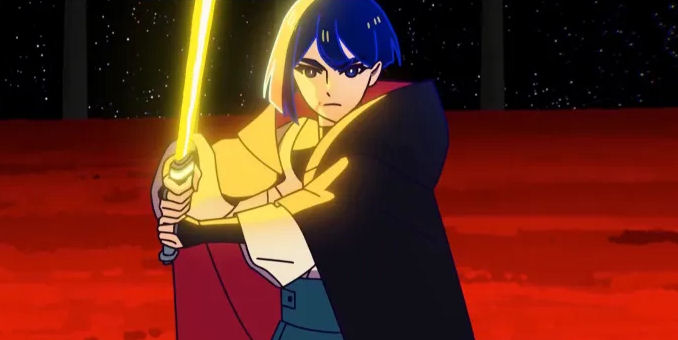
The Star Wars galaxy is a big place, even if it feels like the franchise seems content to confine itself mostly to a few familiar neighborhoods. But Disney+’s animated Star Wars: Visions anthology series isn’t confined by such storytelling straitjackets, and it – and fans – are all the better for it.
Season 3 of Star Wars: Visions is now available on Disney+.
Visions is very much a series for the casual Star Wars fan. Each short is the product of a number of different animation studios from around the world. Unburdened by the needs of canon-bound storytelling, the various enlisted creators can tell self-contained stories that often explore an aspect of the franchise or just their own themes and characters in a way that another Star Wars animated series like Rebels may not be able to.
This third season sees Lucasfilm selecting eight animations studios to contribute their own individual Star Wars tale. (Kinema Citrus contributes two very tonally different entries.) Five of these studios participated in the first season of Visions. And while three episodes here are sequels to ones from that inaugural season, they play well enough on their own without prior knowledge to their predecessors. Sharp-eared viewers may hear the likes of George Takei, Steve Buscemi, Simu Liu, Mark Strong, Freddie Highmore, Masi Oka, and Stephanie Hsu across the various episodes’ voice cast.
The result is nine animated shorts that all use Star Wars as a jumping off point to tell their own stories of adventure, honor, family or friendship in a galaxy far, far away.
As noted before, these films are all outside the regular canon of the franchise, and that’s fine. Some adhere pretty closely to the lore laid down by the films and other TV series, while others just take a few elements and go their own separate way. Some inject new things into Star Wars that play well with what has come before, and sometimes it doesn’t. “The Song of Four Wings”‘s “armor mode” springs to mind as one that doesn’t quite meld with more traditional Star Wars, and that doesn’t make the short a complete dud. And that’s sort of the whole point, mixing and remixing various cultural viewpoints.
Although overall the season mostly maintains a family friendly, the individual episodes do vary somewhat in whom they are aimed at. “Yuko’s Treasure,” with its teddy bear droid and hidden treasure quest, is very much for the younger audience while fans in their teenage years and above will probably find “The Lost Ones” or “The Smuggler” more to their liking.
Perhaps the best of these new outings is “The Bird of Paradise.” In it, a young Jedi trainee is blinded in a lightsaber duel and has to become more attuned to the Force so she can “see” the world around her. As she becomes more versed in doing so, the art style and animation medium changes around her. A close second is “The Duel: Payback,” set in an alternate Fuedal Japan-influenced version of the Star Wars galaxy with a beautiful hand drawn animation style. Remember, Lucas originally wanted well-known Japanese actor Toshiro Mifune to play Obi-Wan Kenobi, so mixing samurai culture into Star Wars is not much of a leap.
But the single wildest swing that the season takes has to be “Black,” a beautifully rendered surreal nightmare that serves as a meditation on the horrors of war. It is a stunning piece of work, and sure to cause some controversy with franchise fans for its exploration of the darker, horrific implications of Star Wars‘s pulp premise.




